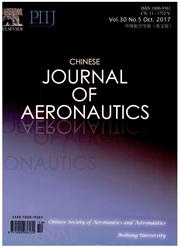

 中文摘要:
中文摘要:
This study seeks to determine the similarities in plume radiation between reduced and full-scale solid rocket models in ground test conditions through investigation of flow and radiation for a series of scale ratios ranging from 0.1 to 1. The radiative transfer equation(RTE) considering gas and particle radiation in a non-uniform plume has been adopted and solved by the finite volume method(FVM) to compute the three dimensional, spectral and directional radiation of a plume in the infrared waveband 2–6 μm. Conditions at wavelengths 2.7 μm and 4.3 μm are discussed in detail, and ratios of plume radiation for reduced-scale through full-scale models are examined. This work shows that, with increasing scale ratio of a computed rocket motor, area of the hightemperature core increases as a 2 power function of the scale ratio, and the radiation intensity of the plume increases with 2–2.5 power of the scale ratio. The infrared radiation of plume gases shows a strong spectral dependency, while that of Al2O3 particles shows spectral continuity of gray media.Spectral radiation intensity of a computed solid rocket plume’s high temperature core increases significantly in peak radiation spectra of plume gases CO and CO2. Al2O3 particles are the major radiation component in a rocket plume. There is good similarity between contours of plume spectral radiance from different scale models of computed rockets, and there are two peak spectra of radiation intensity at wavebands 2.7–3.0 μm and 4.2–4.6 μm. Directed radiation intensity of the entire plume volume will rise with increasing elevation angle.
 英文摘要:
英文摘要:
This study seeks to determine the similarities in plume radiation between reduced and full-scale solid rocket models in ground test conditions through investigation of flow and radiation for a series of scale ratios ranging from 0.1 to 1. The radiative transfer equation (RTE) considering gas and particle radiation in a non-uniform plume has been adopted and solved by the finite volume method (FVM) to compute the three dimensional, spectral and directional radiation of a plume in the infrared waveband 2-6 mu m. Conditions at wavelengths 2.7 mu m and 4.3 mu m are discussed in detail, and ratios of plume radiation for reduced-scale through full-scale models are examined. This work shows that, with increasing scale ratio of a computed rocket motor, area of the high-temperature core increases as a 2 power function of the scale ratio, and the radiation intensity of the plume increases with 2-2.5 power of the scale ratio. The infrared radiation of plume gases shows a strong spectral dependency, while that of Al2O3 particles shows spectral continuity of gray media. Spectral radiation intensity of a computed solid rocket plume's high temperature core increases significantly in peak radiation spectra of plume gases CO and CO2 center dot Al2O3 particles are the major radiation component in a rocket plume. There is good similarity between contours of plume spectral radiance from different scale models of computed rockets, and there are two peak spectra of radiation intensity at wavebands 2.7-3.0 lm and 4.2-4.6 lm. Directed radiation intensity of the entire plume volume will rise with increasing elevation angle. (C) 2016 Chinese Society of Aeronautics and Astronautics. Production and hosting by Elsevier Ltd.
 同期刊论文项目
同期刊论文项目
 同项目期刊论文
同项目期刊论文
 Numerical simulation and experimental study of factors influencing the optical charactersitcs of a s
Numerical simulation and experimental study of factors influencing the optical charactersitcs of a s Steady thermal hydraulic characteristics of nuclear steam generators based on the drift flux code mo
Steady thermal hydraulic characteristics of nuclear steam generators based on the drift flux code mo 期刊信息
期刊信息
